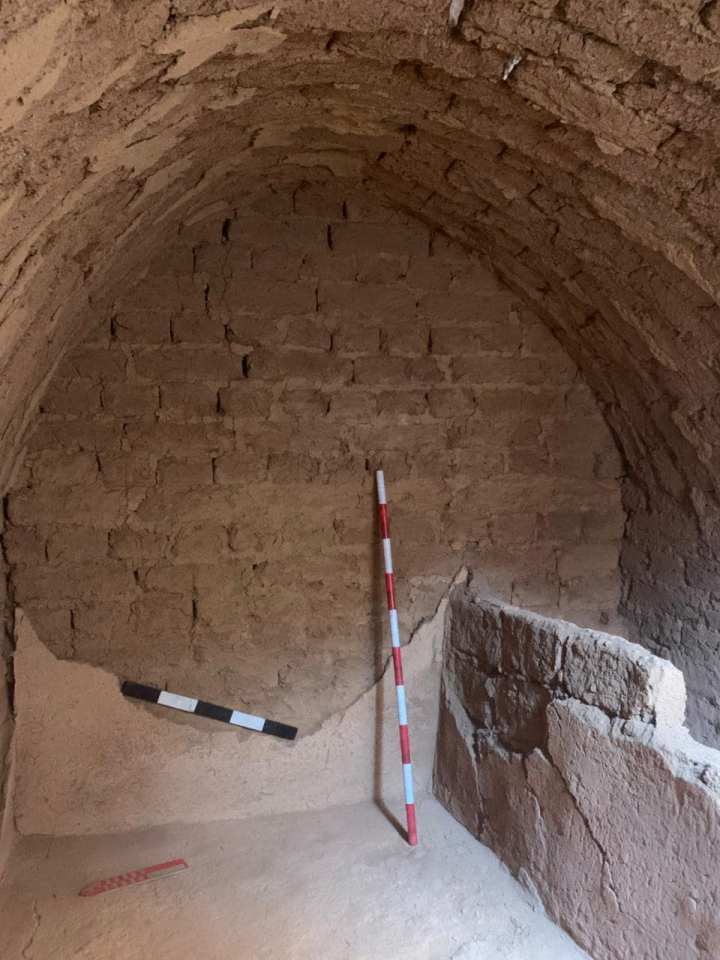ARCHAEOLOGISTS have discovered a huge tomb belonging to one of ancient Egypt’s earliest pharaohs.
But with no mummy left inside the identity of the fallen king remains a mystery.
Ministry of Tourism and Antiquities/Facebook https://www.facebook.com/tourismandantiq/pA tomb thought to belong to one of ancient Egypt’s earliest pharaohs has been discovered in Abydos[/caption]
Ministry of Tourism and Antiquities/Facebook https://www.facebook.com/tourismandantiq/pArchaeologists are unsure which royal ruler the tomb belonged to[/caption]
Ministry of Tourism and Antiquities/Facebook https://www.facebook.com/tourismandantiq/pPottery found in the royal tomb[/caption]
The 3,600-year-old tomb was found nearly 23ft underground in the Mount Anubis necropolis in Abydos.
The long-lost burial site features several rooms as well as 16ft vaults made of mud bricks.
The entrance to the site is painted with scenes showing the goddess Isis and her sister Nephthys – commonly associated with funerary rituals.
Archaeologists also found the remnants of hieroglyphic markings in the tomb’s entrance identifying the royal ruler – but these were undecipherable.
Like many other tombs, this one has sadly been looted and damaged by robbers over the years.
And the mummy and sarcophagus that once lay inside were nowhere to be found – leaving experts puzzled about the identity of the tomb’s owner.
The discovery was made by a joint Egyptian-American archaeological team.
Kathryn Howley, an archaeologist at the Institute of Fine Arts at New York University, said: “We don’t have a huge amount of source material to work with, and that’s why a new discovery like this is so exciting.
“It really has the potential to rewrite the history of ancient Egypt.”
The tomb is thought to belong to a member of the Abydos dynasty, who ruled more than 3,000 years ago.
There are a number of contenders for its owner but the most likely are the ancient pharaohs Senaiib and Paentjeni.
These kings have dedicated monuments elsewhere but no tombs.
The Abydos dynasty is thought to have ruled a region around the city rather than the whole of Egypt.
But the grandeur of the newly-discovered site has left experts wondering whether the dynasty was more powerful than they first thought.
The discovery is the second royal find this year.
The long-lost tomb of King Thutmose II was found close to a vast burial ground known as The Valley of the Kings in Luxor, Egypt back in February.
Archaeologists had previously uncovered Thutmose II’s mummified remains but the original burial site was never found.
King Thutmose II was the fourth Pharaoh of Egypt‘s 18th Dynasty, and is thought to have reigned from about 1493 BC to 1479 BC. He died at the age of 30.
King Thutmose II was married to Queen Hatshepsut, who made history as a powerful female pharaoh.
National Museum of Egyptian CivilizationArchaeologists discovered the long-lost tomb of King Thutmose II in February[/caption]
Egypt Ministry of TourismThe tomb was found close to The Valley of the Kings in Luxor[/caption]
Prior to this, the last royal tomb to be discovered was Tutankhamen, more than 100 years ago.
The tomb was discovered by English archaeologist Howard Carter, who set about finding and excavating it in 1915.
Carter eventually found the site of the pharaoh’s remains in November 1922, but it took another three months before the archaeologist finally found the sarcophagus itself.
Tutankhamen’s tomb is unusually small considering his status, which suggests he may have died unexpectedly before a grander final resting place could be completed.
But there was a dark side to the story – following the unearthing of Tutankhamun’s remains, various figures connected with the expedition died in mysterious circumstances.
These included Lord Canarvon, the financial backer of the excavation team, who died from an infected mosquito bite.
Sir Archibald Douglas-Reid, who X-rayed the pharaoh’s remains, was killed by a mystery illness.
Carter himself died in 1939 from Hodgkin’s Disease aged 64.
King Tutankhamen was discovered by Howard Carter in 1922
Candice Martin/Atlantic ProductionsKing Tut’s tomb had around 5,000 items in when it was uncovered[/caption]

